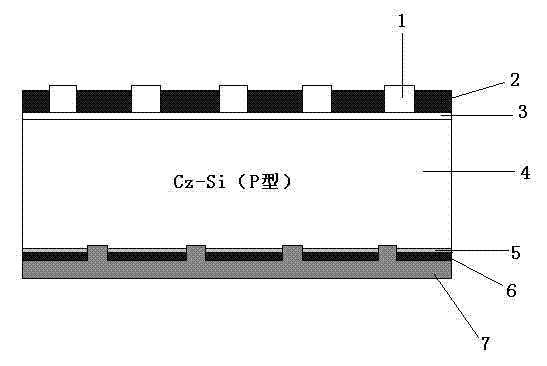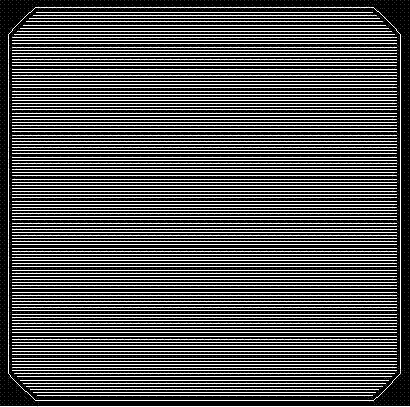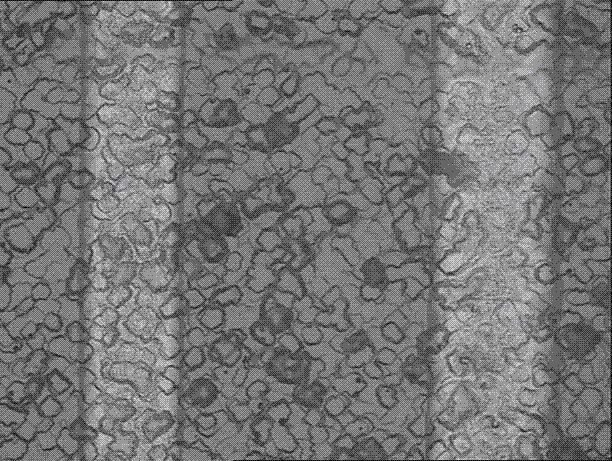Windowing process of solar crystalline silicon battery
A technology of crystalline silicon battery and window opening technology, which is applied in the direction of circuits, electrical components, sustainable manufacturing/processing, etc. Unstable window effect and other problems, to achieve the effect of low thickness uniformity, good applicability, and stable window opening
- Summary
- Abstract
- Description
- Claims
- Application Information
AI Technical Summary
Problems solved by technology
Method used
Image
Examples
Embodiment 1
[0031] (1) Front-end process: Firstly, monocrystalline silicon wafers are placed in a NaOH solution with a mass concentration of 1.2% at 80°C for 15 minutes to form a pyramidal textured structure on the front and back sides, which are then cleaned with pure water and dried; Phosphorus is diffused on the front side of the chip to form an emitter (prior art), and the diffusion resistance is 70R 方 ; With a concentration of 7% HF solution, the phosphosilicate glass on the surface of the silicon wafer is cleaned and dried; then a layer of nitride is deposited on the front of the silicon wafer by PECVD (enhanced plasma vapor deposition method, prior art) Silicon anti-reflection coating with a thickness of 75nm and a refractive index of 2.0;
[0032] (2) Backside polishing: Put the silicon wafers processed in step (1) into the silicon wafer basket, put them into the polishing solution in the chemical polishing tank for chemical polishing for 5 minutes, the chemical polishing temperat...
Embodiment 2
[0038] (1) Front-end process: Firstly, monocrystalline silicon wafers are placed in a NaOH solution with a mass concentration of 1.2% at 80°C for 15 minutes to form a pyramidal textured structure on the front and back sides, which are then cleaned with pure water and dried; Phosphorus is diffused on the front side of the chip to form an emitter (prior art), and the diffusion resistance is 70R 方 ; With a concentration of 7% HF solution, the phosphosilicate glass on the surface of the silicon wafer is cleaned and dried; then a layer of nitride is deposited on the front of the silicon wafer by PECVD (enhanced plasma vapor deposition method, prior art) Silicon anti-reflection coating with a thickness of 75nm and a refractive index of 2.0;
[0039] (2) Backside polishing: Put the silicon wafers processed in step (1) into the silicon wafer basket, put them into the polishing solution in the chemical polishing tank for chemical polishing for 5 minutes, the chemical polishing temperat...
Embodiment 3
[0051] The difference between this embodiment and Example 1 lies in the formula of the etching slurry: the content of each component in the etching slurry is: concentrated phosphoric acid 15%, terpineol 8%, ethyl cellulose 12%, graphite powder 35% %, polyethylene glycol 30%. Others are with embodiment 1.
PUM
| Property | Measurement | Unit |
|---|---|---|
| Thickness | aaaaa | aaaaa |
| Thickness | aaaaa | aaaaa |
| Thickness | aaaaa | aaaaa |
Abstract
Description
Claims
Application Information
 Login to View More
Login to View More - R&D
- Intellectual Property
- Life Sciences
- Materials
- Tech Scout
- Unparalleled Data Quality
- Higher Quality Content
- 60% Fewer Hallucinations
Browse by: Latest US Patents, China's latest patents, Technical Efficacy Thesaurus, Application Domain, Technology Topic, Popular Technical Reports.
© 2025 PatSnap. All rights reserved.Legal|Privacy policy|Modern Slavery Act Transparency Statement|Sitemap|About US| Contact US: help@patsnap.com



